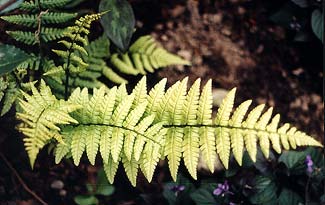 Wallich's Wood Fern
Wallich's Wood Fern
"O'ergrown with bramble bushes, furze & thorn:
That road a narrow path shut in by ferns."
-Thomas Hardy
(1840-1928)
(1840-1928)
We planted Wallich's Wood Fern (Dryopteris wallichiana) near the base of a 'Showa-no-Sakae' camellia. It was such a tiny thing in 2001. By 2003 it was four feet tall!
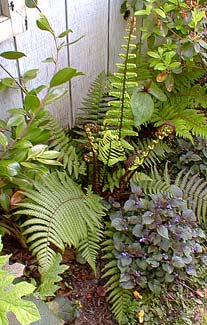 Some ferns are just perfect things in the garden. I would count Wallich's wood fern, Japanese tassel fern, & the western sword fern among the most perfect beauties.
Some ferns are just perfect things in the garden. I would count Wallich's wood fern, Japanese tassel fern, & the western sword fern among the most perfect beauties.This is a widely distributed fern around the globe, mainly in cloud forests at high elevations, often found farther from bogs or stream edges in somewhat drier places than are most ferns. This means it survives drought a bit better than other ferns, though pinnae tips will abort if insufficiently moist & cool.
Though sometimes called the "Himalayan Fern" (probably for the origin of the usual cultivated strain) it is vastly more widely distributed than that, in India, China, Japan, Mexico, South America, Africa, Madagascar, the South Seas & Hawaii. It has black scales on its stalks, rather than brown as encountered on similar sorts of ferns.
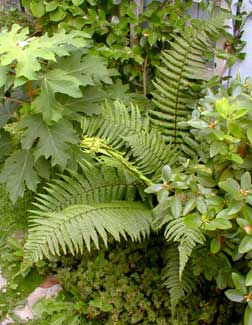 In southern gardens where winter is usually 40 degrees or so, Wallich's wood fern is entirely evergreen. Here in the Northwest it ranges from semi-deciduous to semi-evergreen to just about fully evergreen, depending on the conditions it experiences from garden location & the vaguaries of weather patterns. In the winter of 2001/2002 it got awfully raggedy-looking in the winter, though otherwise very hardy, but through milder winters it retains a fine appearance even through the cold months. In the winter of 2002/2003, perhaps because the clump was larger & better established, if not only because it was an unusually mild winter, it remained entirely evergreen throughout the winter.
In southern gardens where winter is usually 40 degrees or so, Wallich's wood fern is entirely evergreen. Here in the Northwest it ranges from semi-deciduous to semi-evergreen to just about fully evergreen, depending on the conditions it experiences from garden location & the vaguaries of weather patterns. In the winter of 2001/2002 it got awfully raggedy-looking in the winter, though otherwise very hardy, but through milder winters it retains a fine appearance even through the cold months. In the winter of 2002/2003, perhaps because the clump was larger & better established, if not only because it was an unusually mild winter, it remained entirely evergreen throughout the winter.Winter 2004/2005 was unusually cold & all the leaves were very scruffy by winter's end & all of them were spring-trimmed to make room for new leaves. Winter-damaged leaves can be removed in March or April, but they provide some protection to the fern before then. It can be slow to regenerate its leaves, but should have many of its leaves well along in May.
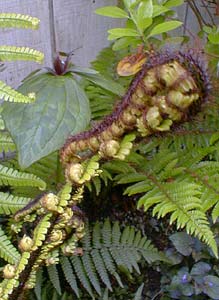 The May 2002 photo at the top of the page is of brand new growth after I cut it back. I took the photo a week or so after clipping out most of the worn growth that remained from the year before. New growth starts out rather yellow. The fifth photo below is also from May (2005), again yellow-green to start with, but very soon hardening off to dark green.
The May 2002 photo at the top of the page is of brand new growth after I cut it back. I took the photo a week or so after clipping out most of the worn growth that remained from the year before. New growth starts out rather yellow. The fifth photo below is also from May (2005), again yellow-green to start with, but very soon hardening off to dark green.The second photo was taken in late April 2003, & as the old leaves were still so nice, I clipped away only a few of them to reveal the fiddleheads. In the second photo the old leaves & the new can be compared. By mid-May it was three feet tall & by June it was four feet tall, with several more fiddleheads coming in & opening for denser appearance.
The third photo was taken in August 2003; it shows the same fern as seen from the opposite end of the path as seen in the second photo. Even in a cold winter it'll look about this great through December, & will only begin to be frazzled by January if there've been enough winter days that fell into the 20s Fahrenheit.
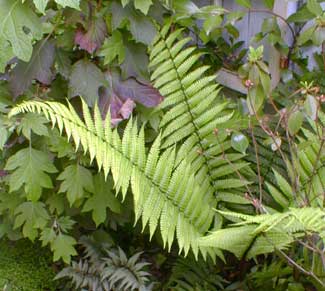 Spring fiddleheads when emerging mid to late April are at first, when small, almost flower-like in their orangeness & shining black spine, folding back over themselves with the appearance of feathered serpents' tails. They open to pale green or sometimes yellow-green, & after hardening to dark green they will retain the striking ebony spine. The fourth photo is from early May 2003, a close up of one of the wonderful fiddleheads just before opening into a new frond.
Spring fiddleheads when emerging mid to late April are at first, when small, almost flower-like in their orangeness & shining black spine, folding back over themselves with the appearance of feathered serpents' tails. They open to pale green or sometimes yellow-green, & after hardening to dark green they will retain the striking ebony spine. The fourth photo is from early May 2003, a close up of one of the wonderful fiddleheads just before opening into a new frond.When the fiddleheads are starting to fully erupt, that is when it is time to remove any of last year's remaining fronds that have gotten homely, which in chillier climes will probably be all of them that made it through the winter, but in our garden it is a year by year decision to cut few, many, or all the previous year's leaves.
If the old fronds are nice enough to save a while longer, the choice could still be made to clip them all off anyway, as this will speed up new growth.
Some other plants are visible in some of these shots, among them Trillium cuneatum immediately behind the Wallich's fern, Viola labridorica purpurea nestled under the front of the fern, & Oakleaf Hydrangea to the left of the fern.
Wallich's fern is capable of growing to the considerable height of six feet, though four feet in three years is more likely, & that's still quite a substantial fern. I thought ours had topped out at three feet but it just kept getting taller, & maybe in years to come it'll actually reach the possible six, forcing me to transplant it elsewhere in the garden to give it more space.
Because of the vase-like upward growth, it is sometimes called "Wallich's Tall Fern" rather than Wood Fern, & this upright stature means if it does continue to enlarge, it ought still to fit narrowly into its already crowded arrangement. It is not usually as wide as it is tall; even so, I've had sometimes to sacrifice a few leaves on one side to keep it from covering the path.